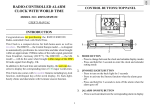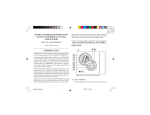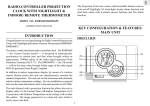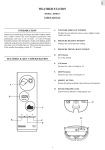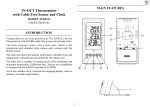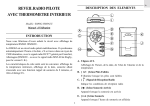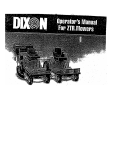Download Oregon Scientific RMR232PHN Thermometer User Manual
Transcript
GB MAIN FEATURES: MAIN UNIT Digital In-Out Thermometer with RF Clock & Photo Frame MODEL: RMR232PHN/RMR232PHU (UK Version) USER'S MANUAL A K B INTRODUCTION C D E F G Congratulations on your purchase of the RMR232PHN/ RMR232PHU, an In-Out Thermometer with Radio-Controlled Clock and a Photo Frame attached. The basic package comes with the following: H -- Main unit (RMR232PHN/RMR232PHU). -- Remote thermo sensor unit I -- Blue and metallic grey exchangeable front key panels. The main unit shows the indoor temperature, calendar clock and temperatures collected and transmitted by the remote unit. The main unit is also capable of keeping track of the maximum and minimum temperature measured. No wire installation is required and the RMR232PHN/RMR232PHU operates at 433MHz. As for the calendar clock, it is radio-controlled. It automatically synchronizes its current time and date when it is brought within an approximate 1500km radius of the radio signal generated from Frankfurt, Germany (DCF77). (MSF 60 for UK Version) You can also set the calendar clock manually when it is off range. Other features include five-language display and two-minute crescendo daily alarm. P J N LM 1 O O GB A THREE-LINE DISPLAY Facilitates easy reading of remote and indoor temperatures and calendar clock B RADIO RECEPTION SIGNAL Indicates the condition of radio reception N C MEMORY [MEM] BUTTON Recalls the maximum or minmum temperature of main and remote unit BATTERY COMPARTMENTS Accommodates two UM3 or “AA” size 1.5V alkaline batteries O TABLE STAND For standing the main unit on a flat surface D UP [ ] BUTTON Advances the value of a setting P WALL-MOUNT RECESSED HOLE For mounting the main unit on a wall E [ MODE/SET ] BUTTON Toggles the display modes and confirms entry while setting the values for display F DOWN [ ] BUTTON Decreases the value of a setting G ALARM [ ] BUTTON Displays the alarm time or sets the alarm status H FRONT PANEL Exchangeable front panel with clip-on design I [ UNLOCK ] BUTTON Unlock the photo frame drawer J PHOTO FRAME DRAWER Holds photo in position. K PHOTO FRAME COVER Protects photo from finger prints and other damages L [ RESET ] BUTTON Returns all settings to default values M [ °C/°F ] BUTTON Selects between degree Centigrade (°C) and Fahrenheit (°F) MAIN FEATURES: REMOTE UNIT B D A C 2 GB A LED INDICATOR Flashes when the remote unit transmits a reading B BATTERY COMPARTMENT Accommodates two UM-3 or AA-size 1.5V batteries C BATTERY DOOR D WALL-MOUNT RECESSED HOLE Supports the remote until in wall-mounting BATTERY INSTALLATION: MAIN UNIT 1. Slide open the battery compartment door. 2. Install 2 alkaline batteries (UM3 or “AA” size 1.5V) strictly according to the polarities shown. BEFORE YOU BEGIN For best operation, 1. Insert batteries for remote units before doing so for the main unit. 2. Place the main unit as close as possible next to the remote unit, reset the main unit after installing batteries. This will ensure easier synchronization between the transmission and reception of signals. 3. Press the [RESET] button. 3. Position the remote unit and main unit within effective transmission range, which, in usual circumstances, is 20 to 30 meters. 4. Replace the battery compartment door. Note that the effective range is vastly affected by the building materials and where the main and remote units are positioned. Try various set-ups for best result. BATTERY INSTALLATION: REMOTE UNIT Though the remote units are weather proof, they should be placed away from direct sunlight, rain or snow. 1. Remove the screws on the battery compartment. 3 GB 2. Lift and open the photo frame cover. 2. Install 2 alkaline batteries (MU-3 or “AA” size 1.5 V) strictly according to the polarities shown. 3. Align and place the photo on the velvet surface. 3. Replace the battery compartment door and secure its screws. LOW BATTERY WARNING When it is time to replace batteries, the respective low-battery indicator will show up on the indoor or outdoor temperature display. HOW TO INSERT A PHOTO 4. Close the photo frame cover and replace it back to the main unit. 1. Push the [UNLOCK] button to unlock and take out the photo frame drawer. 4 GB COMPATIBLE PHOTO SIZES Wall-mount Table Stand Three different standard sizes of photo can be placed in the photo frame: - 8 x12 cm (3.15” x 4.72” ) - 9 x13 cm (3.54” x 5.12” ) - 10 x15 cm (3.94” x 5.9” ) HOW TO USE THE TABLE STAND WALL MOUNTING OR HOW TO EXCHANGE FRONT KEY PANEL The main unit has a table stand which can support the unit on a flat surface. Or you can mount the unit on a wall using the recessed screw hole. The package comes with one grey and one blue exchangeable front panels. As for the remote unit, you can place it on a flat surface or mount the unit on a wall using the recessed screw hole. Main unit Wall-mount Table Stand 5 GB THE RESET BUTTON HOW TO CHECK REMOTE AND INDOOR TEMPERATURES This button is only used when the unit is operating in an unfavorable way or malfunctioning. Use a blunt stylus to hold down the button. All settings will return to their default values. The indoor temperature is shown on the second line of the display. The outdoor temperature is shown on the top line of the display. The kinetic wave display on the outdoor temperature indicates if the reception of the remote unit is in good order. If no readings are received from the remote unit for more than four minutes, blanks “ ” will be displayed until further readings are successfully searched. Check if the remote unit is sound and secure. You can wait for a little while or press [ ] and [ ] simultaneously to enforce an immediate search. GETTING STARTED Once batteries are in place for the remote unit, they will start transmitting temperature readings at 78-second intervals. If the temperature goes above or below than the temperature measuring range of the main unit or the remote unit (stated in specification), the display will show “HHH” or “LLL”. The main unit will also start searching for signals for about four minutes once batteries are installed. Upon successful reception, the outdoor temperature will be displayed on the top line and the indoor temperature on the second line. The main unit will automatically update its readings at about 78-second intervals. HOW TO READ THE KINETIC WAVE DISPLAY The kinetic wave display shows the signal receiving status of the main unit. There are three possible forms: If no signals are received, blanks " " will be displayed and the kinetic wave icon will show “ “. Press [ ] and [ ] simultaneously to enforce another search for about 4 minutes. This is useful in synchronizing the transmission and reception of the remote and main units. 6 GB If that fails, check: 1. The remote unit is still in place. The unit is in searching mode. Temperature readings securely registered. 2. The batteries of both the remote unit and main unit. Replace as necessary. are Note: When the temperature falls below freezing point, the batteries of outdoor units will freeze, lowering their voltage supply and the effective range. No signals. 3. The transmission is within range and path is clear of obstacles and interference. Shorten the distance when necessary. MAXIMUM AND MINIMUM TEMPERATURES TRANSMISSION COLLISION The maximum and minimum recorded indoor and outdoor temperatures will be automatically stored in memory. To display them, press [ MEM ] once to display the maximum temperature and again the minimum temperature. The respective indicators, [ MAX or MIN ] will be displayed. Signals from other household devices, such as door bells, home security systems and entry controls, may interfere with those of this product and cause temporarily reception failure. This is normal and does not affect the general performance of the product. The transmission and reception of temperature readings will resume once the interference recedes. To clear the memory, hold down [ MEM ] for two seconds. The maximum and minimum temperatures will be erased. If you press [ MEM ] now, the maximum and minimum temperatures will have the same values as the current ones until different readings are recorded. NOTE ON °C AND °F The unit of temperature display can be selected by pressing °C / °F button repeatedly. DISCONNECTED SIGNALS If without obvious reasons the display of the outdoor temperature goes blank, press [ ] and [ ] to enforce an immediate search. 7 GB When the RMR232PHN/RMR232PHU is within range, its radiocontrol mechanism will override all manual settings unless autoreception of radio signal has been deactivated. CALENDAR CLOCK DISPLAY MODES The clock and the calendar share the same section of the display. The calendar is displayed in a day-month format. When the unit is receiving radio signal, the radio reception signal will start to blink. A complete reception generally takes about 2 to 10 minutes, depending on the strength of the radio signal. When the reception is complete, the radio reception signal will stop blinking. The strength of the reception for the last full hour will be indicated. - Strong CLOCK MODE - Weak - No Reception CALENDAR MODE - Receiving Each press on the [ MODE ] button will toggle the display between clock and calendar mode. For better reception, place the clock away from metal objects and electrical appliances to minimize interference. If you wish to disable the auto-reception feature, press the [ ] button for two seconds. The radio reception signal will disappear. The unit will not respond to radio signals. To enable the feature again, press the [ ] button for two seconds. The radio reception signal will start blinking to initiate reception automatically. ABOUT RADIO RECEPTION The RMR232PHN/RMR232PHU is designed to automatically synchronize its calendar clock once it is brought within range of the Frankfurt DCF77 radio signal.(MSF for UK Version) 8 GB HOW TO SET THE CALENDAR CLOCK MANUALLY HOW TO SET AND ARM THE ALARM This unit is equipped with a Daily Crescendo Alarm. To set the alarm, To set the clock manually, hold [ MODE/SET ] for two seconds in clock display mode. The 12-hr or 24-hr display will blink. Use [ ] or [ ] to select 12 hour or 24 hour format. Press [ MODE/SET ] to confirm. Repeat the same procedure to set the hour, minutes, year, month, day and display language. During the setting, press and hold [ ] or [ ] will increase or decrease the value rapidly. Note that the date is displayed in DAY-MONTH format. For display language, you can choose among English (E),German(D), French(F), Italian (I) and Spanish (S) . 1. Press [ ] once to display alarm time. If the alarm is deactivated, the time will be displayed as [ -:-- ]. 2. Press [ 4. Press [ 6. Press [ Monday Tuesday Wed. Thursday Friday ] or [ ] . ]. The minute digits will blink. 5. Enter the minutes using [ ] or [ ] . ] to exit. The alarm icon will be displayed indicating the alarm is now armed. You can arm or disarm an alarm by pressing the [ ] button repeatedly. Press [ MODE/SET ] to return to clock display mode. Day-of-the-week Language ] for two seconds. The hour digits will blink. 3. Enter the hour using [ Saturday Sunday Whan an alarm is armed, it will go off at the set time. English German French HOW TO STOP AN ALARM Italian When the alarm goes off, press any key on the unit to stop the alarm sound. Spanish If there is an item you do not wish to change, simply press [ MODE/ SET ] to bypass the item. When you are done, press [ MODE/SET ] to exit. The display will return to the clock mode. 9 GB (23.0°F to 122.0°F) PRECAUTIONS Temperature resolution This product is engineered to give you years of satisfactory service if you handle it carefully. Here are a few precautions: : 0.1°C (0.2°F) 1. Do not immerse the unit in water. Remote unit 2. Do not clean the unit with abrasive or corrosive materials. They may scratch the plastic parts and corrode the electronic circuit. Proposed operating range : -20.0°C to +60.0°C 3. Do not subject the unit to excessive force, shock, dust, temperature or humidity, which may result in malfunction, shorter electronic life span, damaged battery and distorted parts. Temperature resolution : 0.1°C RF Transmission Frequency : 433 MHz (-4.0°F to 140.°F) (0.2°F) 4. Do not tamper with the unit's internal components. Doing so will invalidate the warranty on the unit and may cause unnecessary damage. The unit contains no user-serviceable parts. 5. Only use fresh batteries as specified in the user's manual. Do not mix new and old batteries as the old ones may leak. No. of Remote unit : 1 RF Transmission Range : Maximum 30 meters Radio Controlled Clock 6. Always read the user's manual thoroughly before operating the unit. Main time set and synchronized by Radio Signal DCF77 for Continental/ Central Europe (MSF for UK) 12/24 h display with hh : mm Date Format : Day : Month Day of week selectable in 5 language (E, F, D, I,S) 2-minute crescendo alarm 7. Note:No rechargeable batteries should be used in this product. Only use the type of battery as specified. SPECIFICATIONS Power Temperature Measurement Main unit Main unit : use 2 pcs UM3 or ”AA” 1.5V alkaline battery Remote sensing unit : use 2 pcs UM-3 or “AA” 1.5V alkaline battery Indoor Temperature measurement Proposed operating range : -5.0°C to +50.0°C Weight 10 GB Main unit : 350g (without battery) Remote sensing unit : 46g (without battery) Additional information: The product is therefore conform with the Low Voltage Directive 73/23/EC, the EMC Directive 89/336/EC and R&TTE Directive 1999/5/EC (appendix II) and carries the respective CE marking. Dimension Main unit : 180(L) x 178(W) x 28(T) mm Remote sensing unit : 89(L) x 44(W) x 21(T) mm VS-Villingen / Germany August 2001 Gerhard Preis EC representative of manufacturer EC-DECLARATION OF CONFORMITY RTTE Compliant Countries : All EU countries, Switzerland This product contains the approved transmitter module TX 03 and complies with the essential requirements of Article 3 of the R&TTE 1999/5/EC Directives, if used for its intended use and that the And Norway following standard(s) has/have been applied: CAUTION Efficient use of radio frequency spectrum (Article 3.2 of the R&TTE Directive) applied standard(s) EN 300 220-1(2,3):1997 - The content of this manual is subject to change without further notice. - Due to printing limitation, the displays shown in this manual may differ from the actual display. Electromagnetic compatibility (Article 3.1.b of the R&TTE Directive) applied standard(s) ETS 300 683:1997 - The contents of this manual may not be reproduced without the permission of the manufacturer. Safety of information technology equipment (Article 3.1.a of the R&TTE directive) applied standard(s) EN 60950:1997 11











